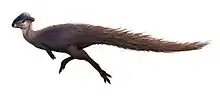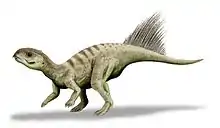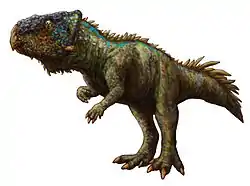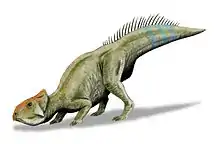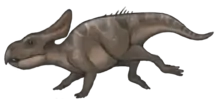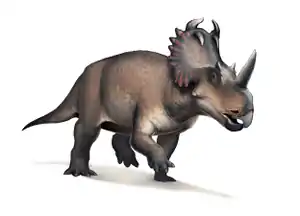Bainoceratops
Bainoceratops (Bain: mountain, keras: horn, ops: face) is a genus of ceratopsian dinosaur from the late Campanian in the Late Cretaceous. This ceratopsian was first described by Tereschenko and Alifanov in 2003 and the type species is B. efremovi.[1] Its fossils were found in southern Mongolia in the Djadochta Formation.
| Bainoceratops | |
|---|---|
| Scientific classification | |
| Kingdom: | |
| Phylum: | |
| Class: | |
| Superorder: | |
| Order: | |
| Infraorder: | |
| Family: | |
| Genus: | †Bainoceratops |
| Binomial name | |
| †Bainoceratops efremovi Tereschenko & Alifanov, 2003 | |
Classification
Bainoceratops belonged to the Ceratopsia, a group of herbivorous dinosaurs with parrot-like beaks which thrived in North America and Asia during the Cretaceous Period, which ended roughly 66 million years ago.
The holotype and only specimen of Bainoceratops is a vertebral column. Even so, enough features are present to distinguish it from Protoceratops and show that it is more closely related to Udanoceratops tschizhovi.[2]
See also
References
- Tereschenko, VS & Alifanov, VR (2003). "Bainoceratops efremovi, a new protoceratopid dinosaur (Protoceratopidae, Neoceratopsia) from the Bain-Dzak Locality (South Mongolia)". Paleontological Journal. 37 (3): 293–302.
- https://web.archive.org/web/20050321170419/http://www.ntux.at/simonkrauter/newdinorama/dinos/b/bainoceratops/daten.htm (in German)
This article is issued from Wikipedia. The text is licensed under Creative Commons - Attribution - Sharealike. Additional terms may apply for the media files.
